 Logo handmade by Bannister
Column by Scott Green
Logo handmade by Bannister
Column by Scott Green
Don't forget to enter to win a signed Paprika poster.

Spotlight: Kung Fu Jimmy Chow
Given that it has been about a decade since Sailor Moon hit TV, Ghost in the Shell hit theaters and Ninja Scroll hit VHS, it is probably fair to say, anime has had a significant momentum in North America for a while now. As such, there's little surprise that plenty of English language parodies have been produced. Elston Gunn not only found Kung Fu Jimmy Chow, one of the rare bread of legitimately funny send-ups, he interviewed the creators, Bob Cesca and his Camp Chaos company. Mall culture and anime are logical co-targets for satire. Working with Speed Racer, modern anime and Shaw Brothers kung fu, and a Japanese take on English at the same time is not the cleanest way of doing parody, but there's no denying that it works; not to mention the success something like Hot Fuzz had with the kitchen sink approach. One would have to be critically humorless not to at least snicker as the title's blazing mall worker makes a bloody mess out of wacky ninjas, assails monkeys and watches as the catch phrases fly. Few online anime-take-off's have brought this much craft to their work. From the infectious theme to the cell shaded animation, Kung Fu Jimmy Chow something different. The episodes only have a few minutes to work with but they set the right beat for the pacing, get in a few solid jokes and close. Anime fans will especially appreciate the spot on opening sequence, but as a whole, it functions well as a clever genre action sendup.
"Sexy girls observe the boy riding fast! Searching for the inexplicable villain... Who utterly killed his Master Chen Happy Awesome Power!" -- excerpt from the KUNG FU JIMMY CHOW theme song If you haven't seen it or heard about it yet, Bob Cesca, John Plummer and Camp Chaos Entertainment (VH-1 ILL-USTRATED) are producing the comedic anime short series KUNG FU JIMMY CHOW delivered to us via Heavy.com. The story centers on Kung Fu Jimmy Chow, a popular goggle-wearing mall employee who fights ninjas while searching for Purple Lady, the villain who killed his master. Anime lovers will enjoy the style and references to which they tip their hats while those unfamiliar with the genre should simply enjoy the action and humor. And as they'll tell you, it's as much homage as it is parody. Visit http://www.heavy.com/channel/2294 for more. It's nothing short of happy awesome. Co-creators Cesca & Plummer and Heavy VP of Programming Jason Marks took some time to answer questions for AICN Anime. [ELSTON GUNN]: What was the impetus for KUNG FU JIMMY CHOW? What inspired the moment for you to say "You know what would be funny? If..." [BOB CESCA (Co-creator, director)]: John and I had been developing another anime comedy series called FAREWELL, MANGA SQUAD which is actually a tribute to- and satire of the SPACE BATTLESHIP YAMATO style of anime shows. John called me with an idea for another anime show called JIMMY CHOW: KUNG FU MASTER, and, of course, I had to mess with the title and changed it to KUNG FU JIMMY CHOW. [JOHN PLUMMER (Co-creator)]: I watch a lot of anime with my hipster seven-year old son. And I would watch him do his version of kung fu from what he was seeing on TV, and I thought it'd be cool to have a kid be this amazing kung fu master, but do it in a sort of American way that both parodies and salutes anime at the same time. Jimmy was originally going to be 7 years old, but Bob wisely pushed for him to be a teenager. Much much better. And I'm a huge Stephen Chow fan, so the name is an homage to the master. [BOB]: From there, we added the mall jobs and villains. [JASON MARKS (VP of Programming at Heavy.com)]: From the Heavy Network perspective, we love working with Bob and John and actually do several projects together, including SUPERFICIAL FRIENDS. With KFJC we wanted something with really high production value, action-oriented, and with a built-in, loyal fan base. Anime, of course, is one of our favorite genres, and we wanted something that would really speak to an anime audience, but bring in a wider crowd, too. That's where the Mall Culture and pop references really plays strongly for us. [EG]: Did you start with characters first, jokes or story? [JOHN]: Kung fu. I'm a triple black belt, so I always start in the dojo, working out my ideas by pummeling my disciples. Everything else follows the pummeling. [BOB]: Trust me, it hurts worse than it sounds. Especially when he skulls my head with a Hot Topic wristband. Actually, I think the characters came first, the story second and the jokes third. After that... more pummeling. [EG]: Will we ever see Jimmy outside of the mall? That's a great setting. [BOB]: Definitely, but his mall jobs are generally where he's ambushed by Purple Ninjas, the shapely fangirls, and various other obstacles. The whole idea is that Jimmy travels across the country on his motorcycle looking for the Purple Lady and in the process has to work these jobs in order to put gas in his bike. He's sort of like David Banner, but with yellow goggles and blue hair. [JOHN]: Yeah, in the first five episodes we're really at the mall, but in the next five, we start to branch out a bit more. Hopefully, we'll get to see a lot more of Jimmy - in the mall and beyond. [JASON]: Mall Culture is important to us, but it's really about getting anime into an American retail setting. Playing up our shallow consumerism and pop values for ironic laughs. I think Jimmy represents the malaise of the minimum wage mall worker and the ninjas are the incarnation of mall culture itself. Jimmy has to kick their asses to save himself, essentially. [EG]: I showed it to someone who said, "I'm inclined to think that doing SPEED RACER, modern anime and Shaw Brothers kung fu at the same time is the cleanest way of doing parody, but there's no denying that it works." Do you agree? Is this basically what you had in mind? [BOB]: I think we always wanted to combine every form of anime -- and Shaw Brothers kung fu -- into one whole. With a bit of Stephen Chow mixed in there. Of course, each influence isn't represented equally, but we also wanted to give the end result a unique look and tone while still clearly being anime. My mandate to Glenn Andrean (who designed the characters) and Joel & Tom Moser, our animators, has been to make it look as close to authentic anime as possible given the tight schedule. And I think it's more of a tribute to the anime we like, and less of a parody per se, isn't it John? [JOHN]: Definitely. A lot of sites have talked about it being a great "anime parody," which is nice and flattering, but I think it's a bit too shorthand. Then again, a lot of movie critics rave about HOT FUZZ being an action movie parody - which it is on one level, but on another level, it's a total homage to action movies and is, in fact, a kickass action movie on its own terms. And on another level it's a satire of every little village TV show that's ever been on the BBC. The point is, it's doing a lot of things at once, and hopefully so are we. Obviously combining all of anime is a tall order, and we're only two episodes in, and the episodes are only four minutes long. But ideally we'll get many more chances to keep piling on our twisted versions of all those great anime conventions we know and love. [JASON]: I think John said it very well. Heavy does a lot of things that push towards parody, but at the end of the day, we don’t want to be reactive, we don’t want to be an imitation but have our shows stand on their own, create new spaces for this kind of entertainment. [EG]: Are you anime fans? What kinds of work did you study for this? [JOHN]: When I was about 8, and I was watching SPEED RACER every day in suburban Chicago, that show had a huge impact on me. The episode when Trixie has a scary vision of Speed morphing into this demon face that used to literally give me nightmares. And I remember watching the episode where Speed tells Racer X in this angry yet sorrowful voice how he wishes he could see his big brother again, and Racer X has to turn away and can't reveal his identity, and I sat there watching in our little TV room and I was just bawling. That was just last year, actually. More recently, I think FULL METAL ALCHEMIST is a brilliant show that eclipses most of everything on American TV (and I'm talking about live action stuff); I love watching NARUTO and CASE CLOSED and ONE PIECE with my son; everything by Miyazaki; GHOST IN THE SHELL; STAND ALONE COMPLEX; GRAVE OF THE FIREFLIES; FLCL; CHRONO CRUSADE; etc. etc. And I've watched a lot of live action kung fu movies. [BOB]: My all time favorite is SAMURAI CHAMPLOO followed closely by the classic SPACE BATTLESHIP YAMATO aka. STAR BLAZERS. As for movies, I really dig GHOST IN THE SHELL, STEAMBOY, PAPRIKA, APPLESEED and everything Leiji Matsumoto and Shinichiro Watanabe have ever done. One of the most underrated anime features was INTERSTELLA 5555, the Daft Punk mini-movie. I also love every single anime opening theme sequence ever made. When I have free time, I page through all the anime shows on Comcast On Demand and annoy my family with the awesomeness of the opening themes. SAMURAI GIRL: REAL BOUT HIGH SCHOOL is my current favorite theme. Oh and John didn't mention his borderline fetishistic collection of hentai DVDs. He's scary into it. [JASON]: Heavy has been a huge fan of traditional anime from the beginning. We are actually working on some deals that will put some CLASSIC anime titles on Heavy.com. We are working to get the rights to slice and dice them, and to make quick hitting mash-up videos out of them. It’s a library we want to offer to our users to play with, as well. [EG]: What's the most challenging aspect of doing this kind of animation? It's completely different from than anything Camp Chaos has done. [BOB]: I don't know where to begin on that one. It's definitely the most challenging short-form series we've ever done -- in all respects, from storytelling to CG animation to action and camera moves and such. I would have to say that, personally, choreographing the fights is both fun and, in terms of drawing skill, way beyond what I should be allowed to do. I draw all the boards myself and since I've never formally studied martial arts, I'm just cobbling together bits of what I've learned from movies and, naturally, the Jhoon Rhee TV commercials I grew up with. From there, the animators have to knock out all that animation and blood in the course of about two or three weeks. So, I think getting all of the action sequences done and on-deadline is an insane task. But Heavy, the network, has been really enthusiastic about this show and they're really getting behind it. That makes everything easier. [JOHN]: I'm embarrassed to even respond to this one. I just write the show with Bob and do a bunch of the voices and voice direction. Bob and the animators do so much more work than I do that I feel like I should probably stop answering this question before people realize that I was lying about my dojo before. [BOB]: John left out his most crucial role on the show: the Clint Howard ninja voice. I have an unhealthy obsession to make a ninja scream out Clint Howard's PARENTHOOD line, "He has no business being out theeeerrre! No businesssss!" [JASON]: We leave it to Bob. He has a range and a sophistication with animation that havent really seen one studio produce. It’s why we continue to work with him and explore new and different programming. [EG]: I love the theme music. That's your first big laugh right there. [BOB]: Billy Sherwood (most excellent music producer and former member of Yes) is entirely responsible for that. I wrote the lyrics in English, then Billy tapped his Japanese in-laws to translate my nonsense into Japanese. I'm not sure how they came up with the translation for "purple nurple" but they did it. When he delivered the final song, it literally established the tone of the whole show. Plus, it accomplishes the goal of making the show appear as if it's an actual Japanese anime which we simply re-cut and re-dubbed. [JOHN]: Yeah, it's great to see some Japanese sites talking about the show and the opening credits and being kind of confused in what my Google translator seems to say is a good way. [BOB]: I once tried to summarize the overall production vibe of the show and came up with the following nonsensical description: It's a Japanese anime produced by Americans about Chinese characters which strives to be animated as if it were made in Japan by Japanese artists who are interpreting their vision of what America is like. My eyes exploded. [JOHN]: Aieee! [EG]: What does the future hold for KUNG FU JIMMY CHOW in terms of story? [JOHN]: Uh, well, lots more blood and a continued stream of incredibly hot women. And the kung fu will get more complex and more mystical, and we'll start to learn a lot more about the backstories of the characters and start to see how complex the web of relationships is. I don't want to say anything too spoilerish. I will give away that in the next episode, you will hear the Purple Lady finally speak and her voice is almost as hot as her mesh shirt. So tune in! [BOB]: John said the kung fu will "get more complex?" He can draw those parts. [EG]: How many more installments are you planning? [BOB]: For now, Heavy has ordered 10 episodes in addition to the pilot, so 11 in all. For now. [JOHN]: Bob and I are personally planning to do this show into our mid-nineties. That's a few more than 11 web-length episodes. Seriously, we're grateful that Heavy loves the show as much as they do and give us a lot of leeway to make it the way we want. It's obviously connecting with a lot of people, and we'd love to build on that and branch out to doing half-hour episodes and a manga and other stuff. You'll see as the episodes appear that the world of Jimmy Chow has limitless possibilities. [JASON]: As long as this success continues and the fans are enjoying their time with KFJC, we will be making more. [EG]: Will these shorts be available on DVD? [BOB]: I really hope so because I want to hear the dialogue translated back into Japanese with English subtitles. [JOHN]: Yeah, ideally this is like a "micro-series" that acts as a springboard for a full-length season on that old school media appliance that I used to watch SPEED RACER on. [JASON]: They will definitely be on DVD. As soon as we produce enough to make it worthwhile, the DVD will be out. We were also a launch partner with Joost and KUNG FU JIMMY CHOW was our premiere title. You can check it out there, now. [EG]: What else are you and Camp Chaos working on? [BOB]: We're producing about five different shows right now, but we really hope to find a home for our next anime project, FAREWELL, MANGA SQUAD. [JOHN]: Yeah, getting to do FAREWELL, MANGA SQUAD would be almost as awesome as getting to make our feature script, THE MIGHTY GOHARU, which we describe as "GODZILLA meets ONE FLEW OVER THE CUCKOO'S NEST." It's live action with rubber suits. Edgar Wright, I'm talking to you. www.campchaos.com www.heavy.com
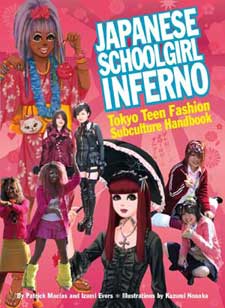
Resource Spotlight: Japanese Schoolgirl Inferno: Tokyo Teen Fashion Subculture Handbook By Patrick Macias and Izumi Evers Illustrations by Kazumi Nonaka
Japanese Schoolgirl Inferno makes a number of references to Kamikaze Girls, a perfect point of reference (and to some degree, instigator) to the vivid fashions adopted by subcultures of Japan's female teenage population. Kamikaze Girls is probably best known for Tetsuya Nakashima's adaptation of the novel about an on the surface unlikely friendship between a loligoth and a yanki. The Rococo-loving former dresses in babydoll gowns, spending her time embroidering and thinking about the outfits on display at Baby, The Stars Shine Bright. The latter travels in a gang-slogan adorned purple overcoat and dreams of of legendary biker brawls. Each looks about as eccentric as the woman who made all the TV evening magazines programs by reporting to jury duty in her Star Trek uniform. Kamikaze Girls' cartoon reality effects, brighter-than-real color scheme and charismatically adorable leads helped foster an impression that that sort of fashion is the domain of wildly imaginative characters. It seems almost incomprehensible that something like Baby, The Stars Shine Bright could be a real CHAIN of stores. When one person dresses in that manner, it seems like an act of mental illness or at least acute maladjustment. When dressing like that spawns a trend, the movement starts looking like a mutant evolution, split from mainstream culture. Then again, couldn't that be said of strains of punk, disco fanatics, hard core sports fans and the like? Japanese School Girl Inferno inspects a selection of the most notable and colorful, fashion identified movements in Japanese, female youth culture throughout recent decades. Its attentive tone comes across as studious people watching rather than gawking. Rather than merely providing an eye catching book that points at the oddly dressed people on the street corner, Japanese Schoolgirl Inferno relates the human story around this collection of rebels and party girls. Rather than ooh and ah and laugh, the book is effective in establishing a context and empathy for the cultures. In discussing these fashions, there is a primary need to suggest how someone could come up with it and why they would leave the house looking that way. In every instance, Japanese Schoolgirl Inferno builds a fascinating case. Some of these fashions challenge all sensibility. Gothloli at least seems like something could spring out of a costume party or concert. Gonguro is something that would inspire incredulity if it was suggested in a work of satire. Described : "They are girls in blackface. There's no other way to describe it. They've drastically darkened the color of their once-fair skin through frequent trips to the tanning salon, piling on cheap tanning products from the drugstore, or, in a pinch, applying good old-fashioned shoe polish. White circles that surround their mouths and eyes (made with concealer) heighten the effect: a chocking hybrid between a human being and a panda bear. Then there is the hair, dyed bizarre shades along the orange-to-blonde spectrum, or tinted silver gray for a style known as "high bleached." Still, given some insight into the mind set, and even the reaction against it, reading Japanese Schoolgirl Inferno, to some degree, it is possible to "get it." The book is divided into three sections: Bad Gals, Sexy Gals and Arty Gals. Under each heading is a set of paired entries for a context (inspiration, myths, popularization and downfall) and a profile. For example "Cute Overload (Mid-1990's to Present) with a profile of the Hello Kitty/character good adorned Decora fashion. The profiles start out with Kazumi Nonaka's illustrations dissecting the look and its accessories, the ideal boyfriend, and in some cases a "Day in the Life" timeline. These images attractively convey the glamor of the style, whether they are meant to suggest carefree brightness, joyfulness, authority, or "I can pull off the walking streets in Pikachu pajamas. In place of illustrated mannequins,Nonaka creates nameless characters around the clothes. The images also have the capacity for suggesting subtle hints of the complete picture behind the life style, such as the cigareete burn scars on the arm of the sukeban tough. Yet, the details do not overwhelm the image. Each image has a precision to the clothes and makeup and accessories, but there is still something about the pastel colors and abstract faces that suggests that edge of non-reality; as if these were the ideal of the subculture rather than an instance of it. The book is less format bound in the text prefaces to the profiles. In addition to researched background, it offers short interviews with fashion adherents, and those who wrote about them in the lifestyle magazines. As eye catching as Nonaka's illustrations are, the book comes into its own with the text pieces. They aren't works of boosterism, selling awe to an audience with a preexisting interest. And they aren't scoffing at the excess (or at least not unduly scuffing) or finger wagging at the associated sins paid dating or shoplifters. As the sukeban "gal"'s scars hint, there is a complex story behind the fashions, and Japanese School Girl Inferno attempts to ferret out that dynamic in its grown-up retrospective on the products of youth culture. Behind the Music stories of the rise and falls of these trends are fit into five or six page passages. Beneath the light, informal prose, there are interesting patterns being drawn in these stories. Despite the colors and creativity, sad or ambivalent codas crop up frequently. The ephemeral nature of creation designed to shock is front and center. Regardless of whether today's creation overshadows yesterday's or yesterday's overshadows todays there is an implicit bleakness in the need for one creation to blot out another. Going outwards the tension trend setters between the trend followers becomes an issue. Whenever the intent involves self-expression, there is a thin line between success and over-exposurer. Whether the outfit is meant as a display of rebellion, artistry or attention grabbing, media and even tourist attention risks hitting that saturation point. As any cynic would guess, economics feed the cycle of popularity and bust. Filter through in unexpected ways. Once something is commoditized for TV, fame seeking wannabe's can dampen the spirits of the party. There is a more tragic flip side. Given the urban nature of the movements' exhibition, the life cycle of these cultures is also influenced by the opportunity or hurtle that they may represent to organized crime. Exploring the stories behind these trends does not preclude Japanese Schoolgirl Inferno from having a sense of humor. It not only recognizes the absurdities, it plays to them. For example, a time line for the unhygienic ogals, who party to the exclusion of showering or sleeping indoors, shows a pair sitting on a park bench, fixing their raccoon banded make-up scaring away small children in the process. The writing treats the subject as an observer would rather than how enthusiast might. It is given to letting the phenomena speak for themselves. There are a number of cutting second hand quips, such as when the book quotes a former magazine editor, talking of the artsy Nagomu Gals, after knocking their appearance. "They were usually timid and shy, but once you got them talking, they could be very noisy and obnoxious. Maybe they were kind of like Goth Girls in America, only without the darkness and the interest in sex." Though the book does have a tongue -somewhere - near cheek way of expressing its opinion, there are fewer cutting lines than Macias' Japanese culture cinema tome, Tokyoscope. Part of letting the story speak for itself is that he's less likely to throw in something counter intuitive to force a reevaluation. The goal obviously wasn't to witicize this topic If you go into Japanese Schoolgirl Inferno looking to laugh at wacky Japanese teens, you might come away with a more circumspect view. Note of warning: watch the bindings on your copy. Japanese Schoolgirl Inferno is an attractive book with glossy full color pages. With the the fold out and blocks of color coded chapters, the copy I purchases came apart.
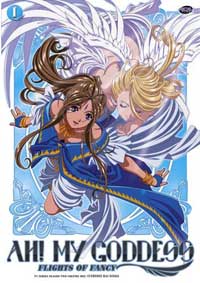
Anime Spotlight: Ah! My Goddess: Season 2, Vol. 1 - Everyone Has Wings Released by ADV Films
Going into its second season, following a manga entering its 19th year, an OVA, a movie and a series of cutesy shorts, new episodes of Ah! My Goddess are still consistently sweet and conservative and probably familiar. The qualities of well made Ah! My Goddess, which the franchise has been for the most part, offer Kosuke Fujishima's trademark elaborately elegant design and a comfortably positive atmosphere. The franchise's anime director Hiroaki Gohda knows how to emphasize these factors and continues to embrace them in this go-around. Returning fans will enjoy the new episodes' pleasing nods to continuity and time given to secondary characters. Given the reliance on simplicity and easy to grasp character humor, the season is also easy to pick up or watch piecemeal. Ah! My Goddess is the prototype for anime/manga stories in which a nobody guy lands himself a relationship with a girl who is not only beautiful, but superhuman. Keiichi Morisato is the put upon runt of a polytech-university. Calling to take-out food he accidentally dials the number for the Goddess Helpline. The goddess Belldandy manifests through dorm's wall, and seeing Keiichi's pure heart, grants him his wish, being his girlfriend. Fate, funneled through screwball humor intervenes, and the couple find themselves living together in a shinto shrine along with Belldandy's troublesome older and younger sisters. The simplicity of Ah! My Goddess' core conceit is the source of its gentle humor, but the consistent straightforwardness of the fairy-tale romance also becomes a limiting constraint as the series stretches. The unevolving nature of the work maintains its leads as young love birds. They stay in college. Compared to the artificial drama found in the love-polygons of other relationship anime/manga, it is pleasant to see two individuals ambiguously committed to each other. However, Ah! My Goddess keeps them in an early stage. In other words, it's not a courtship and not a dynamic relationship. They can't bicker, can't be petty, can't tire of each other. There's no physical intimacy: Belldandy remains a pristine, transcendently wise, motherly nurturer; Keiichi blows a fuse if the topic is broached. Many anime/manga relationship stories stack frustration until there is a final, satisfying release. Rumiko Takashi stacked woe on Maison Ikkoku's Godai for 15 volumes or 96 episodes. In the case of Ah! My Goddess, the satisfying release occurred as the premise was being introduced. The rest is just dwelling in and prolonging that idealized moment. Given its rich Norse legend meets IT department internal mythology, Ah! My Goddess could always introduce some new magical encounter, but the idea for Ah! My Goddess is not meant to fall into a weird-oh of the week holding pattern. When the anime wants to do something significant, it pulls out the tenuous threat of separation from arbitrary mystical decree. This season opens with one case of this, and it doesn't work. The drama is neither fun, nor credible. In the earlier OVA, this was paired with the two working themselves bare trying to producing a gesture of their bond. Paired with an enforced physical separation, it was a tear-jerker. In this television version, it is separated into three episodes: the separation, Belldandy producing a gift for Keiichi, Keiichi producing a gift for Belldandy. Handled with that much space, it becomes obvious. Sweetness and obviousness do get confused in the anime. At this point, a character lighting up, as if they received some revelation and pointing out how special Bellbandy is, or "wow, these two really care for each other" over-sells the case. The same thing is true in the instances where Keiichi says he finds new appreciation for Belldandy. By the end of the volume, the anime has found a clever situation to put its characters into: Belldandy getting drunk. It plays off Belldandy's sweetness, Keiichi's haplessness, it isn't especially pandering, and it looks good. Emphasizing in the series' troubles, getting to that joke is a bit rocky. It veers dangerously close to the kind of series where every girl falls for the male lead, and by in large, that is not what Ah! My Goddess is about. Doing so, it demonstrates that it isn't terribly interesting in moving the development of characters, in this case, the fabulously wealthy "queen" of the campus. Worse yet, it gets there through a literally incredible, out of nowhere beauty pageant, complete with swim suit competition. Maybe what matter most in the at the series looks good. It isn't a heavy action series, but the production handles the complex diversity of character designs impressively well. Catching the face movements and soft expressiveness, it is easy to remember what is endearing about Ah! My Goddess. The bagpipe opening doesn't hurt the series' case either.
New Licenses
ADV Films announced the following anime licenses at Anime Central In addition to magical comedy Magikano, the company licensed the following works from Studio GONZO:: the sexy vampire thriller Red Garden, the critically-acclaimed dark comedy Welcome to the N.H.K. and the sci-fi actioner Pumpkin Scissors Red Garden From studio GONZO and director Kou Matsuo (Rozen Maiden) comes an urban horror masterpiece as sexy as it is disturbing. Unique character designs, stylish settings, and a haunting story make Red Garden one of the most anticipated titles of 2007. Synopsis:. An odd string of suicides surrounds a private institution on Roosevelt Island. On the night a classmate dies, Kate, Rachel, Rose and Claire wake with no memories of the evenings’ events. The next night, the four girls are drawn together by mysterious red butterflies only they can see. Converging at Central Park, the girls are approached by a strange woman who tells them they are dead. Now, the four girls must work together to learn the secrets of their death – and the means to return to their previous life. Red Garden is 24 episodes and will be released over six DVDs. Volume 1 currently is scheduled to go on sale September 18.
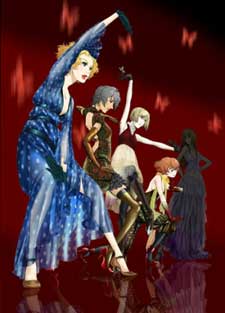
Welcome to the N.H.K. From studio GONZO and director Yusuke Yamamoto (Sgt. Frog) comes Welcome To The N.H.K., the series that turns a humorous eye to the NEET generation (Not In Employment, Education, or Training). Throw agoraphobia into the mix and you’ve got comedy gold! Based on the hit manga series of the same name (published in North America by TOKYOPOP), Welcome To The N.H.K. is a dark comedy filled with social satire, interesting characters, and crazy conspiracy theories. Synopsis: Meet Satou Tatsuhiro, a 22 year-old man who thinks everything around him is wrapped up in some sort of conspiracy. It’s not long before Satou’s conspiracies turn into one big theory… that a secret organization known as the N.H.K. is out to fill the world with reclusive adolescents like himself, also known as hikikomori. Now they’ve upped the ante by using media to turn unsuspecting viewers into otaku, and Satou becomes determined to stop the N.H.K. There’s only one problem – he’s too frightened to even go outdoors! Welcome to the N.H.K. is a 24 episode series presented over six DVDs. Volume 1 currently is scheduled to go on sale October 2.

Pumpkin Scissors Powerhouse studios GONZO and AIC (Solty Rei, Ah! My Goddess) have come together with famed director Katsuhito Akiyama (Thundercats, Guyver: The Bioboosted Armor) to create a masterpiece that has revitalized the war genre in anime. With gorgeous animation, hardboiled characters, and exciting action, Pumpkin Scissors is a series that has it all. Synopsis: A ceasefire is suddenly called between the Royal Empire and the Republic of Frost. Three years later, the lower class of the Empire faces starvation, many of the military units have turned into petty bandits, and those in power are corrupted by greed. To aid in the war relief effort, the Pumpkin Scissors unit is created. The unit’s path is soon crossed with Randel Oland, a mysterious former member of the 901 Anti-Tank Troopers, one of the Army’s top-secret units. Pumpkin Scissors is a 24 episode series presented over six DVDs. Volume 1 currently is scheduled to go on sale October 23. The six volume manga, upon which the anime series based, will be published in North America later this year by Del Rey Manga.

Magikano Based on the manga series from Takeaki Momose (Miami Guns) and directed by Seiji Kishi (Ragnarok The Animation, Yugo the Negotiator) comes a tale on one young man and the many magical girls who protect him. Synopsis: Unbeknownst to average teenager Haruo Yoshikawa, his three sisters have magical powers, which they use to protect him and keep him out of trouble. Everything is going fine until a young witch cursed to lose her powers discovers that Haruo is the boy she needs to break her curse. Now Ayumi Mamiya must awaken the latent powers within Haruo to restore hers. Unfortunately, Haruo’s sisters aren’t going to let her near him without a fight! Magikano is a 13 episode series presented over three DVDs. Volume 1 currently is scheduled to go on sale December 4.
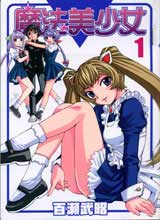
ADV announced the license of Shinichi "Nabeshin" Watanabe (Excel Saga, Nerima Daikon Brothers)'s Wallflower during an appearence to showcase Nerima Daikon Brothers at Houston’s Alamo Drafthouse Cinema. The Wallflower is a comedy based on the best selling shoujo manga series by Tomoko Hayakawa, nine volumes of which have already been published in the US by Del Rey Manga. Synopsis: Kyouhei, Yukinojou, Takenaga and Ranmaru are four gorgeous young men who live in a sprawling mansion owned by a woman they call "Auntie." Auntie tells the boys they may live there for free, but with one catch: they must transform the landlady’s niece Sunako into a proper young lady within three years, or she’ll triple their rent. The boys figure they’re in for smooth sailing, until they discover that Sunako is an introverted, fashion-hopeless, horror-loving movie buff who would rather live like a hermit than undergo a makeover! Our four fabulous guys soon learn they’re in for more than they bargained for as they try to to turn a gore-loving gal into a delicate little flower. The Wallflower is a 25 episode series that will be released over six DVDs, currently scheduled to launch December 18, 2007. FUNimation announced that they have licensed vampire action anime Black Blood Brothers, which will be released across three DVDs starting in 2007.

Media Blasters' AnimeWork will be releasing yuri (lesbian) mecha anime Simoun.
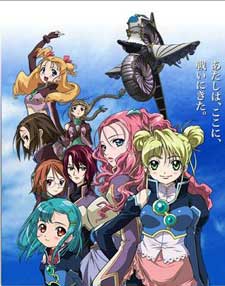
Freedom at Anime Expo
Bandai Visual USA Inc announced it will be participating at Anime Expo 2007 at the Long Beach Convention Center in Long Beach, Calif. June 29-July 2, 2007. Bandai Visual USA will be offering "FREEDOM" volume 1, which will mark the first commercial availability of a high-definition anime title in North America. Bandai Visual USA will be located at booth #1605. Shuhei Morita, the director of "FREEDOM," is expected to be on-hand at the Bandai Visual USA booth, and is scheduled to appear on an industry panel. Born in Nara, Japan and graduated from Kyoto University of Art & Design in 2001 Shuhei Morita started creating motion picture while in college. His achievements include an award for Outstanding Animated Work, Submitted Works General Category of Tokyo International Anime Fair, 2005; Golden Prize, Best Short Film Category of Fantasia Festival, 2005 (Canada); Jury Recommended Works, Japan Media Arts Festival. "FREEDOM" volume 1 (SRP: $39.99) will be simultaneously released in HD DVD/DVD Twin Format (HD DVD layer & DVD layer on single side in one disc) in Japan and the U.S. on June 26, and will be the first introduction of the title in North America. "FREEDOM" will be released in HD DVD, including HDi network function that allows viewers to watch extra features. The DVD has already sold more than 100,000 in Japan, and won top honors at the Tokyo International Anime Fair 2007 for its high-quality animation combining 2D and 3D graphics. The complete series to be released in 6 volumes. The official "FREEDOM" site can be found at www.bandaivisual.us/freedom.
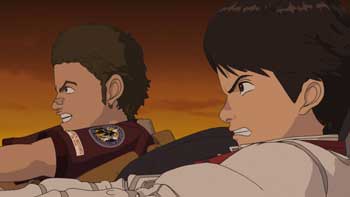
Viz Produces Manga Lounge for Tezuka Exhibit
VIZ Media has announced its partnership with the Asian Art Museum of San Francisco to produce the Manga Lounge which will complement the highly anticipated Tezuka: The Marvel of Manga exhibition. The Lounge will be open May 13 thru September 9, 2007 and coincides with the run of the exhibition, June 2 – September 9, 2007. Comprehensive details are available at www.marvelofmanga.org.
Kosuke Fujishima's Latest
Anime News Network notes that Kosuke Fujishima's (Ah My Goddess, Sakura Wars) latest creation Mel, the mascot character for the new bishojo (cute girl) anime/game magazine Chara*Mel can be seen here. The character will star in the Mel the Quasar novel, which will be serialized in the magazoned. Chara*Mel's first issue is scheduled to be released in Japan on June 25.

The Third Trailer
Anime producer and distributor The Right Stuf International and Kadokawa Pictures USA have unveiled the trailer for THE THIRD: THE GIRL WITH THE BLUE EYE on www.thethirdanime.com. The first DVD will be released on July 31. The 24-episode anime, also known as "The Third – Aoi Hitomi no Shoujo," is based upon a popular series of novels and short stories written by Ryou Hoshino and illustrated by Nao Goto. Spanning more than 16 volumes, the original fiction has appeared in Japan’s Dragon Magazine since 1999, alongside the serialized novels that inspired the hit Full Metal Panic! and Slayers anime series. Additionally, a manga adaptation ran in Dragon Age magazine, home to the Full Metal Panic!, Slayers and Chrono Crusade manga. XEBEC (D.N.Angel, Negima!, Fafner, Elemental Gelade) produced the animation for the TV series, which ran on Japan’s WOWOW satellite channel from April through October of 2006. One Girl. One Tank. No Problem. In a devastated world overrun by monstrous bugs and ravaged by outlaws, there’s only one person to call when you really need a job done right: Honoka. With a sixth sense for danger, sword skills that are second to none, and a smart-aleck A.I. tank by the name of Bogie, she’s ready to tackle any job and solve any problem for her clients. But while crossing the desert one night, she finds a young man alone in the wasteland. It’s the first step of a journey that will challenge even Honoka’s amazing skills to their very limit! Contains episodes 1-4. For more information about The Third: The Girl With the Blue Eye, visit the series site at www.thethirdanime.com. THE THIRD: THE GIRL WITH THE BLUE EYE, VOL. 1: ENCOUNTER Vol. 1 of 6 Pre-Book: 6/26/2007 Street Date: 7/31/2007 Runtime: Approximately 100 minutes, Dolby Digital Stereo, Anamorphic Widescreen, Color Genre: Action / Adventure / Sci-Fi Suggested Rating: 15+ Format: DVD (5.1 and 2.0 English, 2.0 Japanese, English Subtitles, English On-Screen Translations) Catalog#: RSDVD0712 ISBN: 1-57032-754-8 UPC#: 7-42617-0712-2-5 SRP: $24.99 DVD Features: Scene access, Dolby 5.1 mix for English dialogue, Dolby Digital 2.0 Stereo audio for English and Japanese dialogue, English subtitles, plus English on-screen translations. Extras to be announced.
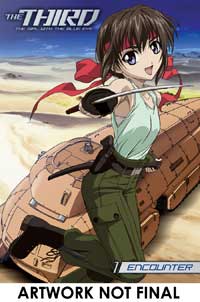
Toei Animation Pushing Licensing
ICV2 reports that Toei Animation's LA subsidiary is opening licensing office run by Coy Edmund to promote their anime properties. For more information, see here
Seattle International Film Screenings
The Seattle International Film (May 24 - June 17) will be screening anime films Paprika and Tekkonkinkreet, notworthly live action films Bugmaster/Mushishi, Hula Girls, and Sakuran/
Studio 4°C Launches Competition
Anime News Network notes that Studio 4°C's MySpace page has announced the "Next Genius" competition, an open video contest for its Genius Party Anthology. Entries can be submitted until June 30th, and will be judged by Genius Party's seven directors, which include Shinichiro Watanabe, Shoji Kawamori, and Masaaki Yuasa.
Summer/Fall Dark Horse Releases
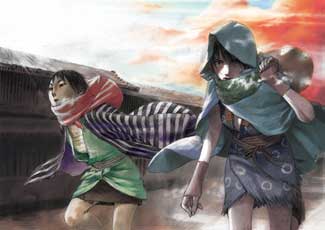
Blade Of The Immortal #128: Badger Hole Part 1 (Of 4) Hiroaki Samura On sale Aug. 8 b&w, 32 pages $2.99 Featuring a wraparound cover and the beginning of a new story arc
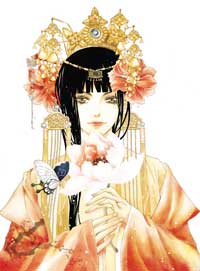
Bride Of The Water God by Mi-Kyung Yun On sale Oct. 10 b&w, 184 pages $9.95 When Soah’s impoverished, desperate village decides to sacrifice her to the Water God Habaek to end a long drought, they believe that drowning one beautiful girl will save their entire community and bring much-needed rain. Not only is Soah surprised to be rescued by the Water God-instead of killed-she never imagined she’d be a welcomed guest in Habaek’s magical kingdom, where an exciting new life awaits her! Most surprising, however, is the Water God himself . . . and how very different he is from the monster Soah imagined. Mi-Kyung Yun received the "Best New Artist" award in 2004 from the esteemed Dokja-manhwa-daesang organization. Bride of the Water God is translated by Heejeong Haas, who has translated a wide variety of American and Korean projects. Heejeong worked as the lead translator for Toon-Us-In-where she translated animation storyboards for The Simpsons and Futurama.
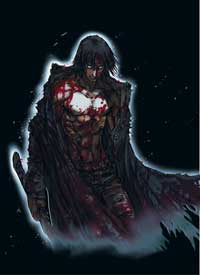
Chunchu: The Genocide Fiend Volume 2 Kim Sung Jae (W) And Kim Byung Jin (A) On sale Oct. 17 b&w, 184 pages $10.95 Life is hard for Chunchu. First his twin brother betrays him within hours of leaving the womb. Then his parents disown him and send him off to live with a warrior tribe and almost certain subsequent death. Growing up an outcast, even members of his tribe and fellow warriors hate him and blame him for any and every death of a loved one. All of this because he’s supposedly "the son of a demon." Sheesh. Kid can’t get a break nowadays. Or then-adays. Whenever "then" is in the frantic and cool fantasy world of Chunchu: The Genocide Fiend. Awarded "Manhwa of the Year" in Korea in 2003
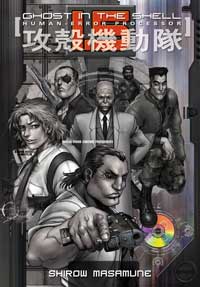
Ghost In The Shell 1.5: Human-Error Processor Shirow Masamune On sale Oct. 10 b&w w/FC, 176 pages $17.95 Deep into the 21st century, the line between man and machine has been inexorably blurred as humans rely on the enhancement of mechanical implants and robots are upgraded with human tissue. In this rapidly converging technoscape, the covert-ops agents of Section 9 are charged to track and crack the most dangerous terrorists, cybercriminals, and ghost hackers the digital future has to offer. Whether dealing with remote-controlled corpses, lethally malfunctioning micromachines, or cop-killer cyborgs, Section 9 is determined to serve and protect . . . and reboot some cybercrook ass! Ghost in the Shell 1.5: Human-Error Processor presents for the first time in America the "lost" Ghost in the Shell stories, created by Shirow.
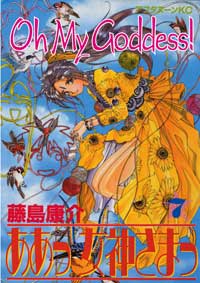
Oh My Goddess! Volume 7 Kosuke Fujishima On sale Oct. 10 b&w, 184 pages $10.95
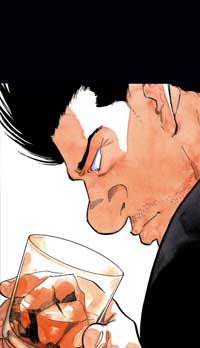
Old Boy Volume 8 Garon Tsuchiya and Nobuaki Minegishi On sale Oct. 10 b&w, 208 pages $12.95
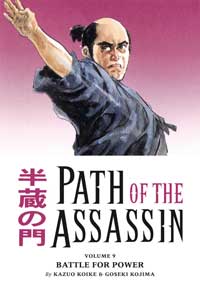
Path Of The Assassin Volume 9: Battle For Power Kazuo Koike And Goseki Kojima On sale Oct. 31 b&w, 304 pages $9.95 TPB, 4" x 6"
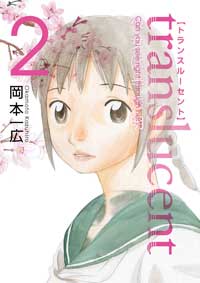
Translucent Volume 2 Kazuhiro Okamoto On sale Oct. 31 b&w, 200 pages $9.95 Shizuka Shiroyama is an eighth grader with a mysterious disease that periodically turns her somewhat transparent . . . and occasionally completely invisible! She needs support from her friends and family to stay solid, both literally and figuratively, and this teen-centric romantic comedy explores both Shizuka’s struggles as she copes with the incredible Translucent Syndrome and her struggles with personal insecurities, early career aspirations, and BOYS! In this volume, Mamoru and Shizuka finally go on an official date, Okouchi-their friend and the student body president-decides to be a pushy cupid, and a trip to the beach leads to some heartbreaking moments.
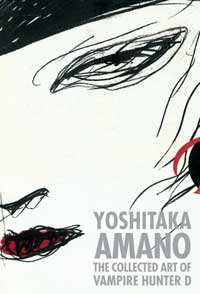
Yoshitaka Amano: The Collected Art Of Vampire Hunter D Hideyuki Kikuchi And Yoshitaka Amano On sale Oct. 24 FC, 392 pages $29.95 TPB w/slipcase Since Dark Horse and Digital Manga Publishing started releasing English-language editions of the Vampire Hunter D novels in 2005, hundreds of thousands of new fans have clamored for more of the enigmatic monster slayer. Following on the heels of the highly successful retrospective Coffin, Dark Horse Books is pleased to present a new collection of paintings, line-art illustrations, and photography by internationally renowned artist and Vampire Hunter D character designer Yoshitaka Amano. This collection also includes a short story, "A Village in Fog" by Vampire Hunter D creator Hideyuki Kikuchi, unavailable elsewhere.
Dragon Dynasty to Release Shaw Brother's Classics
In non-anime news, Genius Products and The Weinstein Company will be releasing the Shaw Brothers' kung fu classic The 36th Chamber of Shaolin, King Boxer, My Young Auntie and One-Armed Swordsman on June 19th on the Dragon Dynasty label. Each DVD will be available for the suggested retail price of $19.95. The 36th Chamber of Shaolin Synopsis: Shedding light on the introduction of Shaolin kung fu to the oppressed Chinese, The 36th Chamber of Shaolin stars Gordon Liu (Kill Bill Vol. I and II) as a young man who trains at a Shaolin Temple in order to seek revenge for the brutal slaughter of his people at the hands of the Manchus. Devoting himself to the study of martial arts, he becomes known as the legendary monk San Te, and single-handedly takes on his people's oppressors. A definitive classic, The 36th Chamber of Shaolin spawned two sequels and helped to launch the North American fascination with Eastern fighting films. The 36th Chamber of Shaolin Special Features Feature Commentary by Film Scholar Andy Klein and The RZA Interview with Star Gordon Liu "Shaolin: A Hero Birthplace" Featurette Interview with Film Scholars David Chute and Andy Klein Commentator Biographies Music Video for Wu-Tang Clan's "Gravel Pit" Posters and Stills Gallery Trailer Gallery
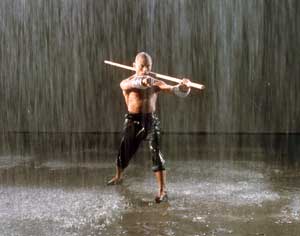
King Boxer Synopsis: King Boxer follows the quest of a gifted young martial arts student as he struggles to win the All-China tournament despite ruthless acts of sabotage by his rivals. King Boxer's stateside theatrical success has earned it the reputation as the first truly international kung fu classic and a paradigm for countless imitators. King Boxer Special Features Feature Commentary by Quentin Tarantino and Film Scholars David Chute and Elvis Mitchell Interviews with Directors Chang-Hwa Jeong and Lau Kar-Leung Interview with Film Scholars David Chute and Andy Klein Featurette from the UK Release Commentator Biographies Posters and Stills Gallery Trailer Gallery
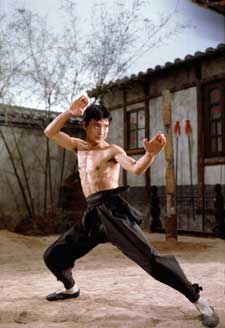
One-Armed Swordsman Synopsis: After his servant father is killed protecting their master, Fang Gang (Jimmy Wang Yu) is raised by the master as his son and trained in swordsmanship. When the master's daughter chops off his right arm in a thoughtless fit of anger, Fang learns a new one-armed style of swordmanship, which he later uses to protect the master in his greatest hour of need. One-Armed Swordsman ushered in the new style of "wuxia" films, showcasing elaborate fantasy coupled with violent swordplay and heavy bloodletting. One-Armed Swordsman Special Features Feature Commentary by Film Scholars David Chute and Andy Klein Interview with Star Jimmy Wang Yu Interview with Film Scholars David Chute and Andy Klein The Master: Cheng Cheh featurette Commentator Biographies Posters and Stills Gallery Trailer Gallery
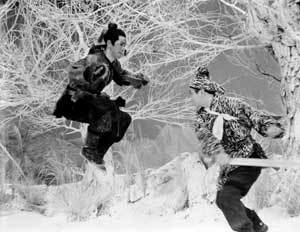
My Young Auntie Synopsis: My Young Auntie blends light-hearted humor with outstanding fight choreography in the story of a two families united by marriages and by the fear of unscrupulous relations seizing the family fortune. Kara Hui (Infernal Affairs 2) earned the Best Actress crown at the Hong Kong Film Awards for her intimate and intensely physical performance. My Young Auntie Special Features Feature Commentary by Film Scholars David Chute and Andy Klein Interview with Star Kara Hui Ying Hung Interview with Film Scholars David Chute and Andy Klein Commentator Biographies Posters and Stills Gallery Trailer Gallery

